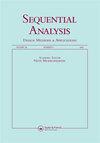A two-stage design for comparing binomial treatments with a standard
IF 0.6
4区 数学
Q4 STATISTICS & PROBABILITY
Sequential Analysis-Design Methods and Applications
Pub Date : 2022-10-02
DOI:10.1080/07474946.2022.2129688
引用次数: 0
Abstract
Abstract We propose a two-stage selection and testing procedure for comparing success rates of several populations among each other and against a desired standard success rate to identify which treatment has the highest rate of success that is also higher than the standard. The design combines elements of both hypothesis testing and statistical selection. As a hybrid two-stage procedure, it allows for dropping the poorly performing treatments early on the basis of interim analysis results or for early termination if none of the experimental treatments seems promising. Because this procedure is not a pure hypothesis testing procedure, power and size are redefined to account for its hybrid nature. Using these definitions, we determine the design parameters for given size and power values. When multiple designs meet these requirements, we will recommend the set of design parameters that produces the lowest expected sample size.比较二项式处理与标准的两阶段设计
我们提出了一个两阶段的选择和测试程序,用于比较几个人群之间的成功率和期望的标准成功率,以确定哪种治疗具有最高的成功率,也高于标准。该设计结合了假设检验和统计选择的元素。作为一个混合的两阶段程序,它允许在中期分析结果的基础上早期放弃表现不佳的治疗,或者在没有任何实验治疗看起来有希望的情况下早期终止。因为这个过程不是一个纯粹的假设检验过程,功率和大小被重新定义,以说明其混合性质。使用这些定义,我们确定给定尺寸和功率值的设计参数。当多个设计满足这些要求时,我们将推荐产生最低预期样本量的设计参数集。
本文章由计算机程序翻译,如有差异,请以英文原文为准。
求助全文
约1分钟内获得全文
求助全文
来源期刊

Sequential Analysis-Design Methods and Applications
STATISTICS & PROBABILITY-
CiteScore
1.40
自引率
12.50%
发文量
20
期刊介绍:
The purpose of Sequential Analysis is to contribute to theoretical and applied aspects of sequential methodologies in all areas of statistical science. Published papers highlight the development of new and important sequential approaches.
Interdisciplinary articles that emphasize the methodology of practical value to applied researchers and statistical consultants are highly encouraged. Papers that cover contemporary areas of applications including animal abundance, bioequivalence, communication science, computer simulations, data mining, directional data, disease mapping, environmental sampling, genome, imaging, microarrays, networking, parallel processing, pest management, sonar detection, spatial statistics, tracking, and engineering are deemed especially important. Of particular value are expository review articles that critically synthesize broad-based statistical issues. Papers on case-studies are also considered. All papers are refereed.
 求助内容:
求助内容: 应助结果提醒方式:
应助结果提醒方式:


